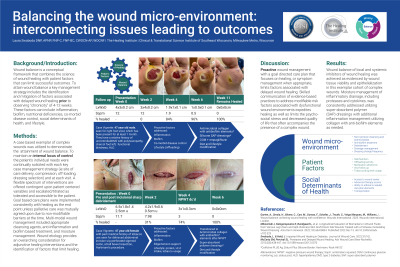Case Series/Study
(CS-138) Balancing the wound micro-environment: interconnecting local and systemic factors

Wound balance is a conceptual framework that combines the science of wound healing with patient factors that can limit successful outcomes. To attain wound balance a key management strategy includes the identification and mitigation of factors associated with delayed wound healing prior to observing “chronicity” of 4-12 weeks. These factors can include inflammation, biofilm, nutritional deficiencies, co-morbid disease control, social determinants of health, and lifestyle.
Methods:
A case based exemplar of complex wounds was utilized to demonstrate the attainment of wound balance. To maintain an internal locus of control the patient’s individual needs were continually solicited with each key case management strategy (ie site of care delivery, compression, off-loading, dressing selection) and at each visit. A flexible spectrum of interventions are offered contingent upon patient centered variables, and escalated/titrated as tolerated and accessible to the patient. Goal based care plans were implemented consistently with healing as the end point unless palliative care was mutually agreed upon due to non-modifiable barriers at the time. Multi-modal wound management including appropriate cleansing agents, anti-inflammation and biofilm based treatment, and moisture management. Wound etiology provides an overarching consideration for adjunctive healing interventions and the identification of factors that limit healing.
Results:
Wound balance of local and systemic inhibitors of wound healing was achieved as evidenced by wound tissue viability and epithelialization in this exemplar cohort of complex wounds. Moisture management of inflammatory drainage, including proteases and cytokines, was consistently addressed utilizing super-absorbent polymer dressings with additional inflammation management utilizing collagen with anti-biofilm elements as needed.
Discussion:
Proactive wound management with a goal directed care plan that focuses on healing, or symptom management when appropriate, limits factors associated with delayed wound healing. Skilled communication of evidence based practices to address modifiable risk factors associated with dysfunctional wound environments expedites healing as well as limits the psycho-social stress and decreased quality of life that often accompanies the presence of a complex wound.
Trademarked Items: Zetuvit: Hartmann USA, South Carolina USA
Colactiv Ag: Hartmann USA, South Carolina USA
Wound Balance: Hartmann USA, South Carolina USA
References: 1. Garten, A., Smola, H., Blome, C., Carr, M., Dumas, F., Schafer, J., Trouth, S., Veiga Marques, M., Williams., L. Wound balance: achieving wound healing with confidence. Wounds International. 2023. Wounds International, London.
2. Mikosiński J, Kalogeropoulos K, Bundgaard L, et al. Longitudinal Evaluation of Biomarkers in Wound Fluids from Venous Leg Ulcers and Split-thickness Skin Graft Donor Site Wounds Treated with a Protease-modulating Wound Dressing. Acta Derm Venereol. 2022;102:adv00834. Published 2022 Dec 13. doi:10.2340/actadv.v102.325
3. Swoboda, L. & Held, J. Impaired Wound Healing in Diabetes. Journal of Wound Care. 2022:31(10).
4. McCarty SM, Percival SL. Proteases and Delayed Wound Healing. Adv Wound Care (New Rochelle). 2013;2(8):438-447. doi:10.1089/wound.2012.0370

.png)